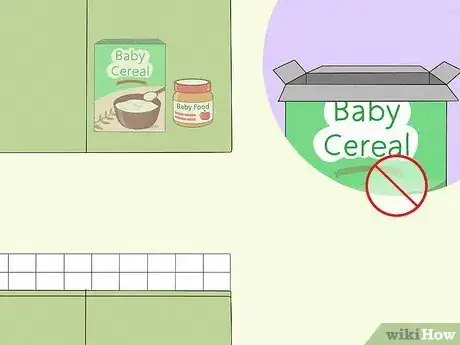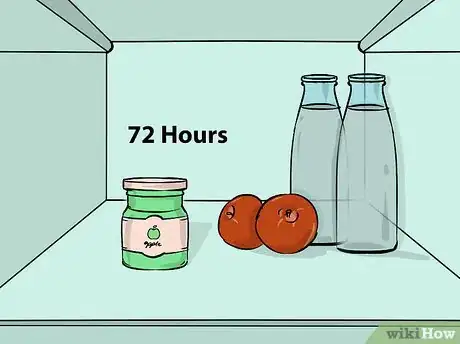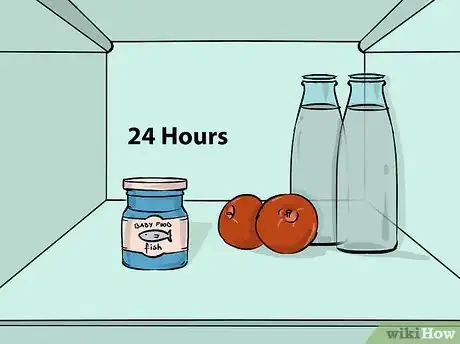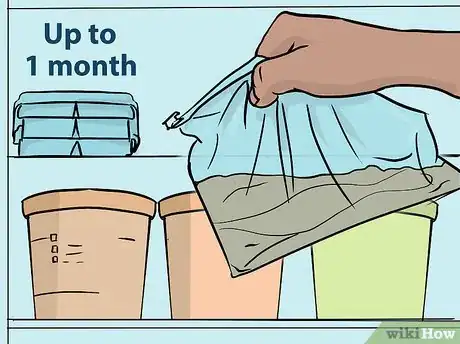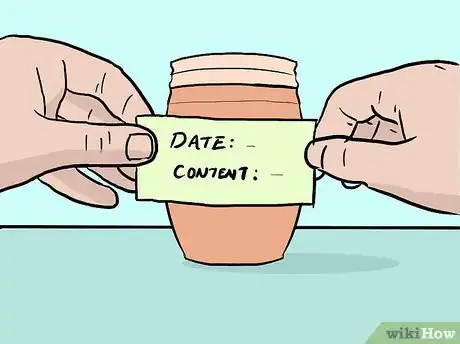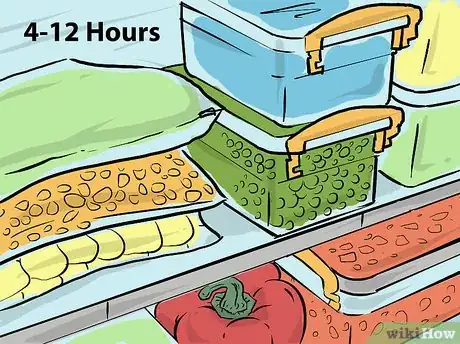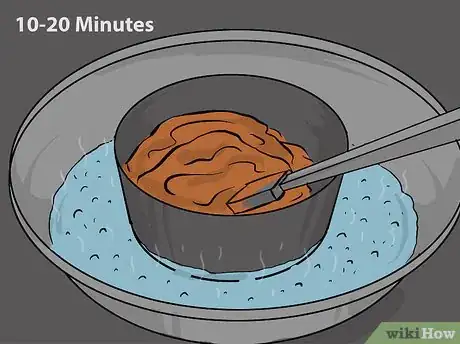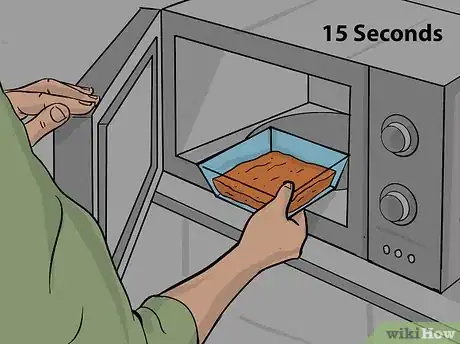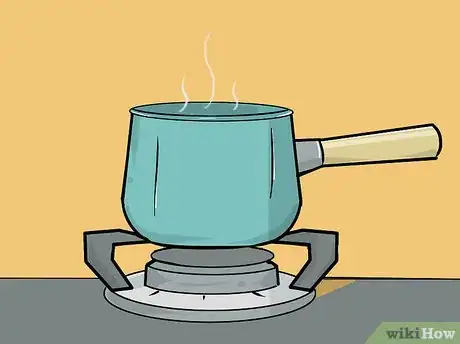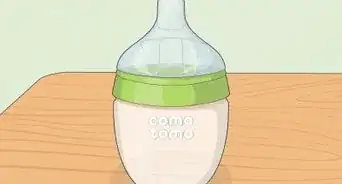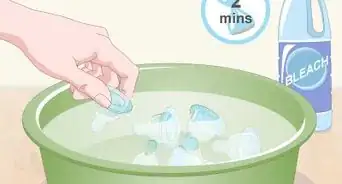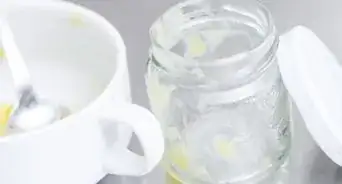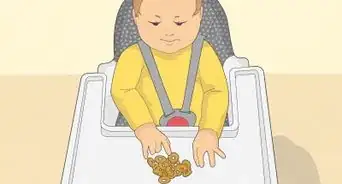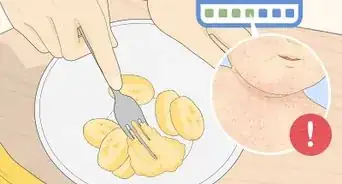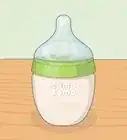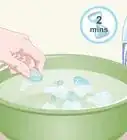This article was co-authored by Amy Chow. Amy Chow is a Registered Dietitian and the Founder of Chow Down Nutrition, a family and child nutrition consulting service in British Columbia (BC), Canada. With over nine years of experience, Amy has a special interest in pediatric nutrition, food allergy management, and eating disorder recovery. Amy holds a Bachelor’s degree in Nutritional Sciences from McGill University. She gained her clinical experiences at residential and outpatient eating disorder treatment programs as well as for BC Children’s Hospital before starting her own business. She has been featured on Find BC Dietitians, Dietitians of Canada, Food Allergy Canada, Recovery Care Collective, Parentology, Save on Foods, National Eating Disorder Information Centre (NEDIC), and Joytv.
There are 9 references cited in this article, which can be found at the bottom of the page.
This article has been viewed 102,015 times.
It’s important to store baby food properly so that it stays safe to consume. Luckily, there are only a couple of simple guidelines to remember! You can store unopened, store-bought baby food in the pantry and any opened or homemade baby food can be stored in the refrigerator or the freezer. Use the refrigerator or the submersion method to thaw frozen baby food and either the microwave or the stovetop to heat it up.
Steps
Keeping Baby Food in the Pantry, Refrigerator, or Freezer
-
1Keep unopened, store-bought baby food in a cool, dark place for 1-2 years. Store-bought baby food typically doesn't require any refrigeration or freezing before it’s used. Keep the baby food unopened in its original plastic container, pouch, or glass jar. Look at the label or the lid of the baby food to see the expiration date and make sure to use the food by that date to ensure that it’s safe for your baby. Keep the baby food in a cool, dark place out of direct sunlight, such as a cupboard or a kitchen pantry.[1]
- It’s safest to discard any store-bought baby food that is past the expiration date.
- Check that the packaging of the baby food is intact. Make sure that the safety seals aren't broken and that the pouches aren't pierced. Return the products to the store if the packaging is damaged.
-
2Refrigerate any fruit or vegetable-based baby food for up to 72 hours. Baby food that is made out of fruits or vegetables is safe to keep in the refrigerator for 3-5 days, regardless of if it’s store-bought or homemade.[2] Transfer the baby food to an airtight glass or plastic container and make sure that the lid is on securely. Then keep the container in the refrigerator up until it’s used or discarded.[3]Advertisement
-
3Keep any meat-based baby food in the refrigerator for up to 24 hours. Baby food that has been made with meat, poultry, or fish doesn’t keep for as long as fruit or vegetable-based foods. Once the baby food has been prepared or opened, transfer it into a plastic or glass airtight container. Then place the container in the refrigerator immediately.[6]
- Discard any meat-based baby food has been refrigerated for more than 24 hours.
- Discard the food if it has an unpleasant odor, doesn't look fresh, or if you have any concerns about it.
-
4Freeze any baby food for up to 2 months.[7] Both store-bought and homemade baby food keep well in the freezer. Place the baby food into a freezer bag or a freezer-safe container. Then keep it in the freezer until it’s used or thrown away. If there is any chance that the baby food may have thawed and refrozen, discard it to be on the safe side.[8]
- Try to freeze the baby food within 2 hours of it being prepared or opened.[9]
- You can freeze fruit, vegetable, and meat-based baby foods.
- If you're freezing homemade baby food, it's recommended to freeze it in serving size containers.
-
5Label any baby food with the expiration date before it’s refrigerated or frozen.[10] If you are storing a lot of baby food, it can be tricky to keep track of all of the expiration dates. Use a marker or a label-maker to add the expiration date to the lid of each container of baby food that you store. You can also add what the baby food is if you need a reminder.[11]
- Try to store the containers of baby food that have the nearest expiration dates at the front so that you know what to reach for first.
Thawing and Heating up Baby Food
-
1Thaw frozen baby food over 4-12 hours in the refrigerator. The refrigerator is the best way to thaw baby food if you don’t need to use it straight away. Simply remove the container of baby food from the freezer and place it in the refrigerator. Depending on the contents of the baby food, it will take 4-12 hours to thaw. Use the baby food within 24 hours of it being in the refrigerator.[12]
- Make sure that the baby food is in a sealed container in the refrigerator to prevent bacterial growth.
- The length of time that it takes for the baby food to thaw depends on the density. For example, a very small, ice cube-sized portion of pureed fruit will thaw much faster than a larger potion of a meat-based food.[13]
-
2Submerge frozen baby food in hot water to thaw it in 10-20 minutes. This is a quick and easy way to thaw baby food evenly. Get a large bowl and fill it with hot water. Transfer the frozen baby food into a smaller bowl and place it into the large bowl with the hot water. Then wait for the baby food to thaw and stir it occasionally to check if it’s still frozen at all. Use the baby food immediately once it has thawed.[14]
- Be careful that the hot water doesn’t overflow when you add the smaller bowl.
- The submersion method is also the best way to thaw frozen breastmilk.
-
3Heat up baby food in the microwave in 15-second intervals. If the baby food is in a plastic container or pouch, transfer it to a glass container or a microwave-safe dish. Then place the container into the microwave and begin heating it up in short increments. Stir the baby food in between each 15-second interval to make sure that it heats up evenly and to prevent heat pockets from forming. Always try the baby food before you give it to your baby to make sure that it’s not too warm.[15]
- Never place plastic containers or pouches in the microwave.
- You can also thaw frozen baby food in the same way.
-
4Use the stovetop to heat up baby food if you don’t have a microwave. The stovetop is another easy way to heat up baby food. Place the baby food into a small saucepan and place the saucepan on the stovetop. Then adjust the temperature to a low heat and use a wooden spoon to stir the baby food as it warm up. This helps the baby food to warm evenly.[16]
- It’s best to use a low heat to heat up the baby food, as this prevents it from becoming too hot. However, it's always best to check that the food isn't too hot before you serve it.
- You can also use the stovetop to thaw frozen baby food.
Expert Q&A
-
QuestionHow long is baby food good for in the fridge?
 Amy ChowAmy Chow is a Registered Dietitian and the Founder of Chow Down Nutrition, a family and child nutrition consulting service in British Columbia (BC), Canada. With over nine years of experience, Amy has a special interest in pediatric nutrition, food allergy management, and eating disorder recovery. Amy holds a Bachelor’s degree in Nutritional Sciences from McGill University. She gained her clinical experiences at residential and outpatient eating disorder treatment programs as well as for BC Children’s Hospital before starting her own business. She has been featured on Find BC Dietitians, Dietitians of Canada, Food Allergy Canada, Recovery Care Collective, Parentology, Save on Foods, National Eating Disorder Information Centre (NEDIC), and Joytv.
Amy ChowAmy Chow is a Registered Dietitian and the Founder of Chow Down Nutrition, a family and child nutrition consulting service in British Columbia (BC), Canada. With over nine years of experience, Amy has a special interest in pediatric nutrition, food allergy management, and eating disorder recovery. Amy holds a Bachelor’s degree in Nutritional Sciences from McGill University. She gained her clinical experiences at residential and outpatient eating disorder treatment programs as well as for BC Children’s Hospital before starting her own business. She has been featured on Find BC Dietitians, Dietitians of Canada, Food Allergy Canada, Recovery Care Collective, Parentology, Save on Foods, National Eating Disorder Information Centre (NEDIC), and Joytv.
Registered Dietitian Depending on what's in the baby food, anywhere from 3-5 days. If you think you won't finish it within that time frame, I suggest storing it in the freezer.
Depending on what's in the baby food, anywhere from 3-5 days. If you think you won't finish it within that time frame, I suggest storing it in the freezer. -
QuestionWhat can you do with leftover baby puree?
 Amy ChowAmy Chow is a Registered Dietitian and the Founder of Chow Down Nutrition, a family and child nutrition consulting service in British Columbia (BC), Canada. With over nine years of experience, Amy has a special interest in pediatric nutrition, food allergy management, and eating disorder recovery. Amy holds a Bachelor’s degree in Nutritional Sciences from McGill University. She gained her clinical experiences at residential and outpatient eating disorder treatment programs as well as for BC Children’s Hospital before starting her own business. She has been featured on Find BC Dietitians, Dietitians of Canada, Food Allergy Canada, Recovery Care Collective, Parentology, Save on Foods, National Eating Disorder Information Centre (NEDIC), and Joytv.
Amy ChowAmy Chow is a Registered Dietitian and the Founder of Chow Down Nutrition, a family and child nutrition consulting service in British Columbia (BC), Canada. With over nine years of experience, Amy has a special interest in pediatric nutrition, food allergy management, and eating disorder recovery. Amy holds a Bachelor’s degree in Nutritional Sciences from McGill University. She gained her clinical experiences at residential and outpatient eating disorder treatment programs as well as for BC Children’s Hospital before starting her own business. She has been featured on Find BC Dietitians, Dietitians of Canada, Food Allergy Canada, Recovery Care Collective, Parentology, Save on Foods, National Eating Disorder Information Centre (NEDIC), and Joytv.
Registered Dietitian There are plenty of things you can use it for! You can add it to soups, stews, and pasta sauces. You can also eat it plain as an alternative to apple sauce.
There are plenty of things you can use it for! You can add it to soups, stews, and pasta sauces. You can also eat it plain as an alternative to apple sauce.
Warnings
- Don’t store containers of food that you have fed your baby directly from. This is because the saliva that’s transferred to the food in the container can cause harmful bacterial growth.[19]⧼thumbs_response⧽
References
- ↑ https://www.fsis.usda.gov/wps/portal/fsis/topics/food-safety-education/get-answers/food-safety-fact-sheets/safe-food-handling/shelf-stable-food-safety
- ↑ Amy Chow. Registered Dietitian. Expert Interview. 16 September 2020.
- ↑ https://www.foodsafety.gov/blog/homemade_babyfood.html
- ↑ https://www.babycenter.com/0_baby-food-basics_9194.bc
- ↑ https://abcnews.go.com/Health/Germs/story?id=5560174&page=1
- ↑ https://www.foodsafety.gov/blog/homemade_babyfood.html
- ↑ Amy Chow. Registered Dietitian. Expert Interview. 16 September 2020.
- ↑ https://www.babycenter.com/0_baby-food-basics_9194.bc
- ↑ https://www.babycenter.com/0_baby-food-basics_9194.bc
- ↑ Amy Chow. Registered Dietitian. Expert Interview. 16 September 2020.
- ↑ https://www.foodsafety.gov/blog/homemade_babyfood.html
- ↑ https://www.verywellfamily.com/thawing-baby-food-cubes-284421
- ↑ https://www.fsis.usda.gov/wps/portal/fsis/topics/food-safety-education/get-answers/food-safety-fact-sheets/safe-food-handling/the-big-thaw-safe-defrosting-methods-for-consumers/ct_index
- ↑ https://www.verywellfamily.com/thawing-baby-food-cubes-284421
- ↑ https://www.babycenter.com/0_baby-food-basics_9194.bc
- ↑ https://wholesomebabyfood.momtastic.com/heatandthawhomemadebabyfood.htm
- ↑ Amy Chow. Registered Dietitian. Expert Interview. 16 September 2020.
- ↑ Amy Chow. Registered Dietitian. Expert Interview. 16 September 2020.
- ↑ https://www.fda.gov/food/resourcesForyou/healtheducators/ucm089629.htm
